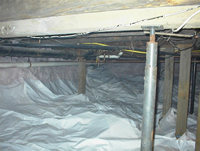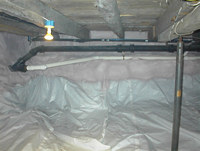|
||||
|
|
|
|
|
|
|
|
|
|
|
|
Basements and Crawl spaces
Problems which may have been identified:
-
You have a crawl space or basement that is cold.
-
You have pipe freeze-ups.
-
The floors upstairs are cold and drafty.
-
Your building shifts, or cracks appear when the ground freezes.
-
Your basement has a musty smell, mold, or mildew.
FOAM-TECH has completed hundreds of stone basement and crawl space foundation projects over the last 20 years. Typically, we only insulate the sills and the tops of the walls to one or two feet below grade. This gives the best payback as the tops are exposed to the coldest temperatures and the source of cold air infiltration. Leaving the bottom of the wall exposed reduces the likelihood of frost heave action and reduces costs. If the stonewalls have air passages inside the stones (sometimes they are laid up on both the inside and the outside with rubble fill between the two walls), we seal any unpointed cracks that are leaking below grade.
|
||||||||||||
We install vapor retarders (see photos above and below) on the dirt floors of crawl spaces (and sometimes basements). We run these up the walls and trap the top of the vapor retarder in the bottom of the foam to allow seasonal or ground water to escape under the vapor retarder to a drainage area without providing moisture to the interior space. This provides a complete system which we call the AVID system.
|
Related Information










